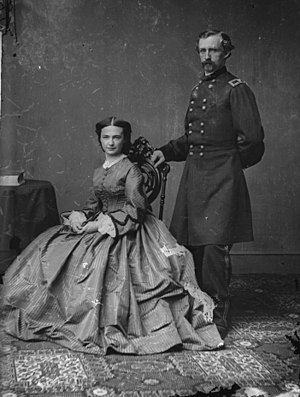The website of the exhibit presents the art on an interactive timeline where you can scroll through the decades, viewing the images and listening to a montage of newscasts and music from the era.
This image of a WWI machine gunner was produced in 1918 by Captain Harvey Dunn, a combat artist assigned to the American Expeditionary Forces in France.
In 1917, the American military designated "official war artists" who were sent to Europe to record the activities of American Forces there and like many of them, Captain Harvey Dunn was formally trained. Dunn had studied at the Chicago Art Institute then later under the famed adventure novel illustrator Howard Pyle.
"Unlike the objective camera lens that records the single instant and no more, the artist not only captures instantaneous action, but can fuse earlier moments of the same scene into a compelling image. Observation, insight, elimination of confusing detail, and focusing on the essential can all be compassed by the artist's eye." - U.S. Navy Combat Art Program
The Navy's Combat Art Program was officially founded in 1941 after muralist Griffith Baily Coale, convinced the Navy's top brass of the importance of having competent artists on the battlefields to record the history that was taking place. Not to be outdone, the Army established a War Art Unit in late 1942. The War Art Advisory Committee selected 23 active duty military and 19 civilian artists to work in the program.
But in May 1943 Congress withdrew funding from the program and the War Art Unit was inactivated.
The effort to create a visual record of the American military experience in World War II was then taken up by the private sector in two different programs, one by Life magazine and one by Abbott Laboratories, a large medical supply company. When Life offered to employ civilian artists as was correspondents, the War Department agreed to provide them the same support already being given to print and film correspondents. Seventeen of nineteen civilians artists who had been selected by the War Art Committee joined Life as war correspondents. A deal was struck between, then editor of Life, Daniel Longwell and the Secretary of War for the artists to receive the same treatment as news correspondents.[1] Abbott, in coordination with the Army's Office of the Surgeon General, commissioned twelve artists to record the work of the Army Medical Corps. These two programs resulted in a wide range of work by distinguished artists who had the opportunity to observe the war firsthand." - The United States Army Art Program, Wikipedia
The Navy Combat Art Program was revived with two military artists in the Korean War and in the Vietnam era the program operated with civilian artists in cooperation with the Salmagundi Club. The Navy also began sending artists to cover a broader array of naval activities in addition to combat. Following the merger of the Navy Combat Art Program with the Naval Historical Center, artists have been sent to the Persian Gulf and Desert Shield/Storm. - Naval History and Heritage Command
Since my husband served as a combat engineer during the Vietnam War and has often told me how getting enough sleep was a daily challenge between sweeping roads for mines all day then standing guard half the night, I was particularly drawn to this image entitled "The Waiting Game" by Sp6 Kenneth J. Scowcroft depicting two exhausted members of the 4th Infantry Division near the flight line at the heliport on Dragon Mountain in Plieku, Vietnam . I think my husband would have titled it "Catching ZZZZsss!" though.
If you're going to be in the Philadelphia area before the end of March, I would urge you to stop by Constitution Center and view these images that capture the sacrifice our young men and women have made over the last 100 years. If you can't make it in person, I recommend visiting the website and viewing the online gallery. The art truly depicts the human dimension of war "in a way no photograph or newsreel ever could!"




War Diary of a Combat Artist















